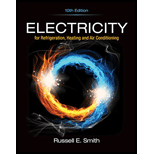
Electricity for Refrigeration, Heating, and Air Conditioning (MindTap Course List)
10th Edition
ISBN: 9781337399128
Author: Russell E. Smith
Publisher: Cengage Learning
expand_more
expand_more
format_list_bulleted
Textbook Question
Chapter 2, Problem 24RQ
What is an insulator?
Expert Solution & Answer
Want to see the full answer?
Check out a sample textbook solution
Students have asked these similar questions
What is the basic difference between adsorption and absorption?
what is a thermistor
Describe the process of Control of Heat Loss by Conduction?
Chapter 2 Solutions
Electricity for Refrigeration, Heating, and Air Conditioning (MindTap Course List)
Ch. 2 - All physical objects are composed of __________....Ch. 2 - What is an atom?Ch. 2 - Which of the following is a part of the atom? a....Ch. 2 - What is static electricity?Ch. 2 - Name three ways electricity can be produced.Ch. 2 - What part do protons and electrons play in the...Ch. 2 - Which of the following is the simplest atom that...Ch. 2 - What are the four most important characteristics...Ch. 2 - What is electromotive force?Ch. 2 - Electromotive force is commonly measured in _____....
Ch. 2 - What is current?Ch. 2 - How is current measured? a. amperes b. ohms c....Ch. 2 - What is resistance?Ch. 2 - How is resistance commonly measured? a. amperes b....Ch. 2 - What is electrical power?Ch. 2 - How is electrical power commonly measured? a....Ch. 2 - Where do electrons exist in an atom, and what is...Ch. 2 - True or False: All atoms tend to lose electrons.Ch. 2 - State the law of electric charges.Ch. 2 - What is a proton? Where does it normally exist in...Ch. 2 - Describe briefly the method a dry cell battery...Ch. 2 - What is a conductor?Ch. 2 - Which of the following is the best conductor? a....Ch. 2 - What is an insulator?Ch. 2 - Which of the following is the best insulator? a....Ch. 2 - Why do metals make the best conductors?Ch. 2 - How do electric utility companies charge customers...Ch. 2 - What is the meaning of SEER when used in...Ch. 2 - State Ohms law.Ch. 2 - True or False: Ohms law applies to all types of...Ch. 2 - What is the ampere draw of a 5000-watt electric...Ch. 2 - What is the resistance of the heating element of...Ch. 2 - What is the voltage of a small electric heater if...Ch. 2 - What is the Btu/hour output of an electric heater...Ch. 2 - What is the kilowatt output of an electric heater...
Knowledge Booster
Learn more about
Need a deep-dive on the concept behind this application? Look no further. Learn more about this topic, mechanical-engineering and related others by exploring similar questions and additional content below.Similar questions
arrow_back_ios
SEE MORE QUESTIONS
arrow_forward_ios
Recommended textbooks for you
 Refrigeration and Air Conditioning Technology (Mi...Mechanical EngineeringISBN:9781305578296Author:John Tomczyk, Eugene Silberstein, Bill Whitman, Bill JohnsonPublisher:Cengage Learning
Refrigeration and Air Conditioning Technology (Mi...Mechanical EngineeringISBN:9781305578296Author:John Tomczyk, Eugene Silberstein, Bill Whitman, Bill JohnsonPublisher:Cengage Learning Welding: Principles and Applications (MindTap Cou...Mechanical EngineeringISBN:9781305494695Author:Larry JeffusPublisher:Cengage Learning
Welding: Principles and Applications (MindTap Cou...Mechanical EngineeringISBN:9781305494695Author:Larry JeffusPublisher:Cengage Learning Understanding Motor ControlsMechanical EngineeringISBN:9781337798686Author:Stephen L. HermanPublisher:Delmar Cengage Learning
Understanding Motor ControlsMechanical EngineeringISBN:9781337798686Author:Stephen L. HermanPublisher:Delmar Cengage Learning Automotive Technology: A Systems Approach (MindTa...Mechanical EngineeringISBN:9781133612315Author:Jack Erjavec, Rob ThompsonPublisher:Cengage Learning
Automotive Technology: A Systems Approach (MindTa...Mechanical EngineeringISBN:9781133612315Author:Jack Erjavec, Rob ThompsonPublisher:Cengage Learning

Refrigeration and Air Conditioning Technology (Mi...
Mechanical Engineering
ISBN:9781305578296
Author:John Tomczyk, Eugene Silberstein, Bill Whitman, Bill Johnson
Publisher:Cengage Learning

Welding: Principles and Applications (MindTap Cou...
Mechanical Engineering
ISBN:9781305494695
Author:Larry Jeffus
Publisher:Cengage Learning

Understanding Motor Controls
Mechanical Engineering
ISBN:9781337798686
Author:Stephen L. Herman
Publisher:Delmar Cengage Learning

Automotive Technology: A Systems Approach (MindTa...
Mechanical Engineering
ISBN:9781133612315
Author:Jack Erjavec, Rob Thompson
Publisher:Cengage Learning
Microelectronics Fabrication Center; Author: AnritsuCompany;https://www.youtube.com/watch?v=oDC6WWj3gmk;License: Standard Youtube License